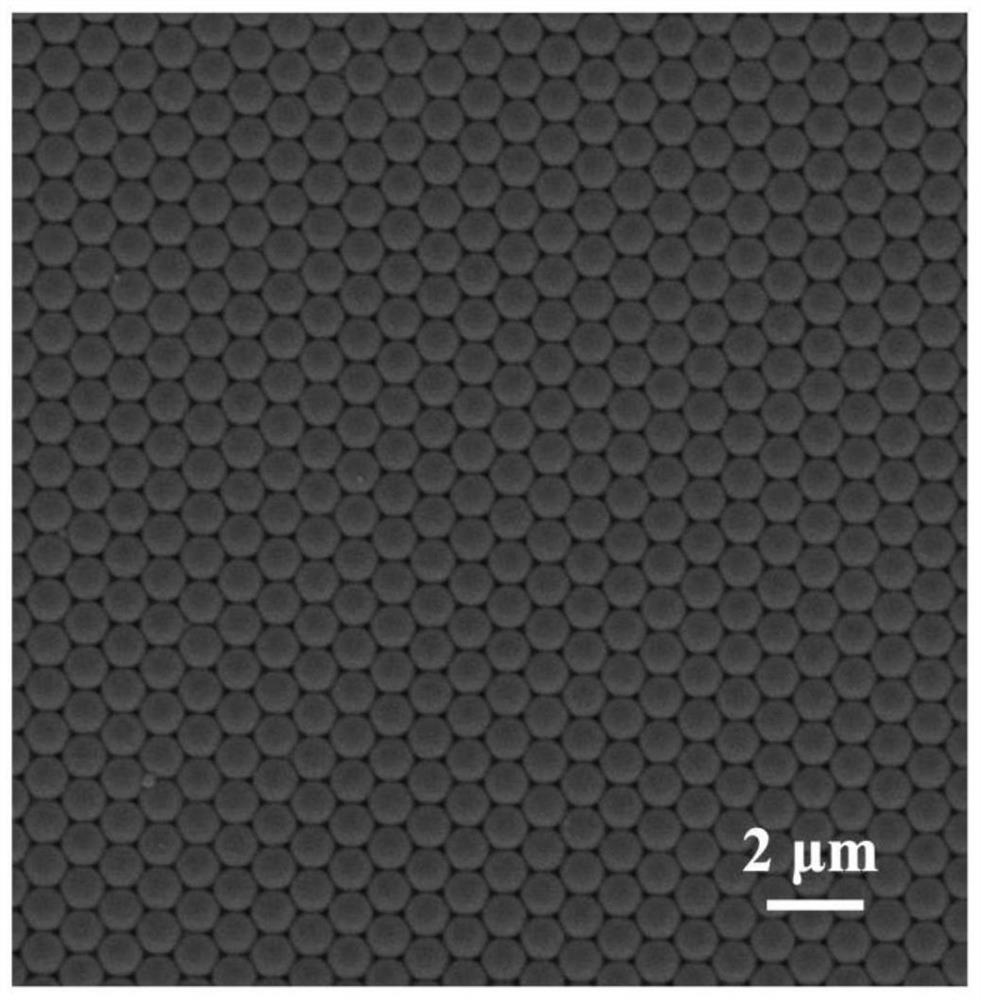Porous PDMS film with two-dimensional inverse opal structure and preparation method thereof
An inverse opal structure, PDMS technology, applied in the field of PDMS film and its preparation, can solve the problem of destroying the ordered structure, and achieve the effect of simple method
- Summary
- Abstract
- Description
- Claims
- Application Information
AI Technical Summary
Problems solved by technology
Method used
Image
Examples
Embodiment 1
[0025] The temperature of the heating plate was set to 50 °C, the substrate was placed on the heating plate, and 1 mL of 10 mg / mL dispersion of monodisperse polystyrene microspheres with a particle size of 500 nm was carefully dropped onto the substrate. After the solvent evaporates, the deposition of polystyrene microspheres is completed. The 500 nm polystyrene microsphere self-assembled membrane was immersed in ethanol for 1 h, then removed and carefully dried on the backside of the substrate using a gentle nitrogen stream. Finally, the substrates were annealed on a hot plate at 90 °C for 10 min to remove any residual solvent and ensure good contact between the polystyrene microspheres and between the polystyrene microspheres and the substrate.
[0026] The polystyrene microsphere self-assembled membrane was infiltrated with a mixture of silicone oil and PDMS prepolymer (the weight ratio of PDMS binder to curing agent was 10:1) (the mass ratio of silicone oil to PDMS prepoly...
Embodiment 2
[0029] The heating plate temperature was set to 50 °C, the substrate was placed on the heating plate, and 1 mL of 10 mg / mL monodisperse polystyrene microspheres with a particle size of 2 μm dispersed droplets were carefully applied on the substrate. After the solvent evaporates, the deposition of polystyrene microspheres is completed. The 2 μm polystyrene microsphere self-assembled membrane was immersed in ethanol for 1 h, then removed and carefully dried on the backside of the substrate using a gentle nitrogen stream. Finally, the substrates were annealed on a hot plate at 90 °C for 10 min to remove any residual solvent and ensure good contact between the polystyrene microspheres and between the polystyrene microspheres and the substrate.
[0030] The polystyrene microsphere self-assembled membrane was infiltrated with a mixture of silicone oil and PDMS prepolymer (the weight ratio of PDMS binder to curing agent was 10:1) (the mass ratio of silicone oil to PDMS prepolymer was...
Embodiment 3
[0033] The temperature of the heating plate was set to 50 °C, the substrate was placed on the heating plate, and 1 mL of 10 mg / mL monodisperse polystyrene microspheres with a particle size of 1 μm dispersed droplets were carefully applied on the substrate. After the solvent evaporates, the deposition of polystyrene microspheres is completed. The 1 μm polystyrene microsphere self-assembled membrane was immersed in ethanol for 1 h, then removed and carefully dried on the backside of the substrate using a gentle stream of nitrogen gas. Finally, the substrates were annealed on a hot plate at 90 °C for 10 min to remove any residual solvent and ensure good contact between the polystyrene microspheres and between the polystyrene microspheres and the substrate.
[0034] The polystyrene microsphere self-assembled membrane was infiltrated with a mixture of silicone oil and PDMS prepolymer (the weight ratio of PDMS binder to curing agent was 10:1) (the mass ratio of silicone oil to PDMS pr...
PUM
| Property | Measurement | Unit |
|---|---|---|
| Particle size | aaaaa | aaaaa |
Abstract
Description
Claims
Application Information
 Login to View More
Login to View More - R&D
- Intellectual Property
- Life Sciences
- Materials
- Tech Scout
- Unparalleled Data Quality
- Higher Quality Content
- 60% Fewer Hallucinations
Browse by: Latest US Patents, China's latest patents, Technical Efficacy Thesaurus, Application Domain, Technology Topic, Popular Technical Reports.
© 2025 PatSnap. All rights reserved.Legal|Privacy policy|Modern Slavery Act Transparency Statement|Sitemap|About US| Contact US: help@patsnap.com



